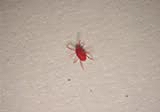

Having a spring barrier applied by a professional can go a long way to preventing them and minimizing disturbances when they do have population outbreaks. Preventing these invasions can be quite difficult.

Now that they are here, what do we do about them? Treatment & Prevention This leads to vast numbers of exodus toward your home or business. There is no hunting for the perfect mate. There is no need to have some fancy pants mating dance. They reproduce by parthenogenesis which means they can get the entirety of the reproductive job done themselves. So now that we know what they are, why are there so many? ParthenogenesisĬlover mites are rather interesting. Because of their size, they can penetrate the tiniest cracks and seems in homes. Though they are harmless to humans, they are quite a disturbance. These are small landscape mites that love to invade structures. So who is this 4 legged mini creature? Clover Mite

It is also worth noting that these are less than a mm in length, so counting legs can be a rather aggravating ask. The detail that throws most people off is their front legs often extend far forward and can be confused quite easily with antennae. Most of these calls that we deal with do not actually have 3 pairs of legs but have 4. If there are 6 legs and 2 antennae and reddish in color, it could be any one of many ant species: A good place to start on this investigation is counting legs. Yeah, apparently color is harder to go off of than we would wish. “What are you guys looking at, that is clearly yellow!” “Hold on, I think it is brown with hints of red” I have lost count of how many times I have been looking at the same ant with 4 other people and here: Or is it? Unfortunately, pests are not strong at adhering to the primary colors. While tiny is relative, red is pretty clear. Not only do the stains annoy us, but it doesn’t seem to make a dent in their invading forces. Bright red and super small, any attempt to squash out their persistence results is bright red streaks and stains.
Tiny red bugs free#
Tiny red bugs plus#
Organic approaches – Insecticidal Soap, Fertilome Fruit Tree Spray, Horticultural Oil Spray, Triple Action Plus Insect Spray.Applications of these products should be applied every 5 to 7 days for 21 continual days because the spider mite has a 5 to 7 day reproductive cycle and it’s important to break that chain.īurger Farm and Garden recommend the following products to control spider mites… The plant may also have some webbing on the underside or on the branches of plant. The best way to control red spider mites is through the use of insecticidal soaps and oils. Close inspection will reveal that the dust is actually moving and is in fact the spider mites. A plant that is infested by red spider mites will start to look unhealthy and will have a dusty appearance to the undersides of their leaves. Red Spider Mites however are garden pests that affect a wide variety of plants. Clover mites are generally just a nuisance.īurger Farm and Garden recommends using Bug Blaster Bifenthrin 2.4 to control Clover Mites. They are not harmful to people or pets and will not harm your plants or lawn. Every once in a while populations can get very large and the mites start to migrate from the grass. Clover mites are sometimes confused with red spider mites. Clover mites generally live and feed in grass and for the most part remain unnoticed. If you would happen to crush one of them, they can leave a red stain. They are small, reddish mites, about the size of a pin head and usually moving around very quickly. In late spring to early summer you tend to see the “little red spiders” and what you see are most likely Clover mites (Bryobia praetiosa). Clover mites are relatively harmless while red spider mites are a garden pest that you will need to control. First of all you need to figure out if the “little red spiders” are clover mites or red spider mites.


 0 kommentar(er)
0 kommentar(er)
